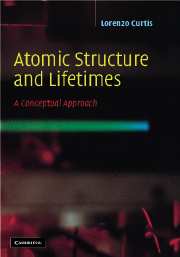Book contents
- Frontmatter
- Contents
- Preface
- List of physical constants and useful interrelations
- 1 Introduction
- 2 Semiclassical conceptual models
- 3 Semiempirical parametrization of energy-level data
- 4 The vector model of angular momentum
- 5 The intermediate coupling model
- 6 Electric dipole radiation
- 7 Line strengths in two-valence-electron systems
- 8 Magnetic dipole transitions
- 9 Absorption of radiation
- 10 Time-resolved measurements
- 11 Hyperfine structure
- 12 Electrostatic polarizabilities and long-range interactions
- 13 Coherence and anisotropic excitation
- References
- Index
3 - Semiempirical parametrization of energy-level data
Published online by Cambridge University Press: 06 July 2010
- Frontmatter
- Contents
- Preface
- List of physical constants and useful interrelations
- 1 Introduction
- 2 Semiclassical conceptual models
- 3 Semiempirical parametrization of energy-level data
- 4 The vector model of angular momentum
- 5 The intermediate coupling model
- 6 Electric dipole radiation
- 7 Line strengths in two-valence-electron systems
- 8 Magnetic dipole transitions
- 9 Absorption of radiation
- 10 Time-resolved measurements
- 11 Hyperfine structure
- 12 Electrostatic polarizabilities and long-range interactions
- 13 Coherence and anisotropic excitation
- References
- Index
Summary
What seems like black and white drabness, can reveal hidden color sublime; you need only to look at it deeply, and see it one part at a time.
Historical development
The study of optical radiation, dispersed to reveal its frequency content, has a long and venerable history. However, the fact that this radiation consists of a continuous distribution of colors when emitted by free ions in a dense plasma or solid, and of a discrete distribution of lines of color when emitted by an atomic gas, was long unnoticed. The first recorded observation of the dispersed solar (ark) spectrum is usually attributed to Noah, who beheld the rainbow after the flood. In Genesis 9:13, God is reported to have said “I have placed my rainbow in the clouds.” Regrettably, no revelation of the Fraunhofer lines was reported.
The first published observation of a dispersed solar spectrum using a slit and a prism was by Isaac Newton in his 1666 treatise on optics. Again, Newton made no mention of observing dark lines superimposed on the continuous “Phænomena of Colours.” The first recorded observation of a line spectrum was by Thomas Melvill in 1752. Melvill inserted a piece of sea-salt into a flame and allowed the emitted radiation to pass through a slit onto a prism. He noted a “constancy of refrangeability” of the bright yellow sodium light.
The observation of seven dark lines superimposed on the solar spectrum was noted by William Wollaston in 1802, and that number was increased to several hundred by Joseph Fraunhofer in 1814. In 1859 Robert Bunsen and Gustav Kirchhoff combined the experiments of Melvill and Fraunhofer to launch the field of laboratory astrophysics.
- Type
- Chapter
- Information
- Atomic Structure and LifetimesA Conceptual Approach, pp. 42 - 71Publisher: Cambridge University PressPrint publication year: 2003



